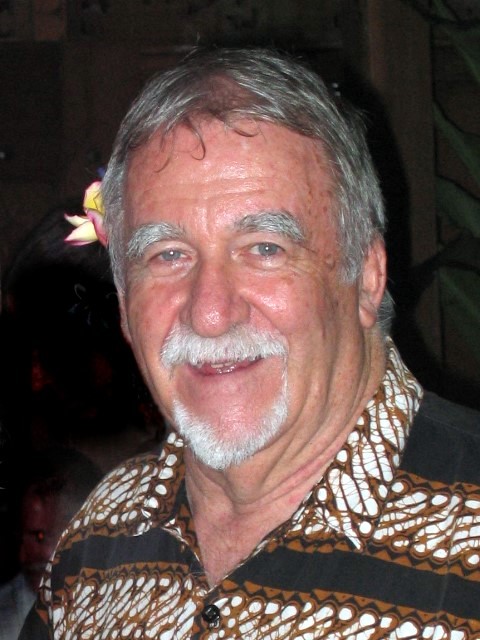
ロバート・E・ブラウン
Robert E. Brown, 1927-2005

Bob Brown ca. 2004
☆ ロバート・エドワード・"ボブ"・ブラウン(1927年4月18日 - 2005年11月29日)はアメリカの民族音楽学者であり、「ワールド・ミュージック」という言葉を生み出したことで知られている。こ れらの録音の多くは、米国で初めて広く配布され、商業的に入手可能となったもので、インドネシアのガムラン音楽を研究し、演奏する世代のミュージシャンに インスピレーションを与えた。
| Robert
Edward "Bob" Brown[1] (18 April 1927 – 29 November 2005) was an
American ethnomusicologist who is credited with coining the term "world
music".[2][3][4] He was also well known for his recordings of music
from Indonesia. Many of these recordings, among the first widely
distributed and commercially available in the United States, inspired a
generation of musicians to study and perform Indonesian gamelan music. Brown grew up in Clinton, New York. He had a very extensive background in music while still young. He played timpani and bass drum in a band, double bass and cello in the school orchestra and accompanied the school chorus on piano. A sponsor enabled him to study music theory at the Utica Conservatory with Johannes Magendanz and study piano with Clara Magendanz. He performed the first movement of the Schumann piano concerto with the high school orchestra during his sophomore year. The same year, he held the job of organist at Hamilton College. He also performed popular music with his own band, Bobby Brown and His Swingsters. During his undergraduate years at Ithaca College and his graduate studies at Cornell University he continued to work as an organist. Bob Brown started his doctoral studies at UCLA as a piano major in 1953. After Mantle Hood began teaching at UCLA the following year, Brown switched to ethnomusicology and became Hood's first teaching assistant. Brown received his doctorate in ethnomusicology from UCLA. His dissertation was titled The Mrdanga: A Study of Drumming in South India (1965). He studied and played the mridangam. Brown began teaching at Wesleyan University in 1961.[5] He founded the world music/ethnomusicology program at Wesleyan. It was here that Brown first used the term "world music" to describe the ethnomusicology program. Bob Brown followed the philosophy advocated by Mantle Hood, who could be considered the father of gamelan music education in the USA: that students become bi-musical. Bob Brown's own "World Music" programs from the 1960s onwards were built on the ideal of bi-musicality, which was an innovative approach to music education at the time. It proposed that students, after acquiring competence in the music of their native culture, study with master musicians from another culture, and thereby acquire competence in the musical performance and theory of that culture too. The result would be a person with musical competence in two cultures: bi-musicality. Brown was one of the organizers of the American Society for Eastern Arts (ASEA). In 1973, Brown founded the Center for World Music. He remained president of the organization until his death. Thinking about how much musical experience was available to him in high school motivated him to start the "Music in the Schools program" for the Center for World Music. Brown began teaching at San Diego State University in 1979. He served as the Chair of the School of Music for three years from 1979 to 1982. He retired in 1992. Brown also was the owner of Girikusuma or Flower Mountain, a center for traditional Balinese performing arts located in Bali. In 2006, The University of Illinois Urbana-Champaign announced that Brown had bequeathed his extensive collection of instruments, recordings, books, paintings and artifacts and to the school's world music center. The Robert E. Brown Center for World Music, which opened in April 2008, was named in his honor.[6] |
ロ
バート・エドワード・"ボブ"・ブラウン[1](1927年4月18日 -
2005年11月29日)はアメリカの民族音楽学者であり、「ワールド・ミュージック」という言葉を生み出したことで知られている[2][3][4]。こ
れらの録音の多くは、米国で初めて広く配布され、商業的に入手可能となったもので、インドネシアのガムラン音楽を研究し、演奏する世代のミュージシャンに
インスピレーションを与えた。 ブラウンはニューヨークのクリントンで育った。彼はまだ若いうちから非常に幅広い音楽のバックグラウンドを持っていた。バンドではティンパニとバスドラム を、学校のオーケストラではコントラバスとチェロを演奏し、学校のコーラスではピアノの伴奏をしていた。スポンサーにより、ユティカ音楽院でヨハネス・マ ゼンダンツに音楽理論を、クララ・マゼンダンツにピアノを師事した。高校2年生のとき、オーケストラとシューマンのピアノ協奏曲の第1楽章を共演。 同年、ハミルトン・カレッジのオルガニストを務める。また、自身のバンド、ボビー・ブラウン&ヒズ・スウィングスターズでポピュラー音楽を演奏した。イサカ・カレッジでの学部時代とコーネル大学での大学院時代もオルガニストとしての活動を続けた。 ボブ・ブラウンは1953年、ピアノ専攻としてUCLAで博士課程を開始した。翌年マントル・フッドがUCLAで教鞭をとり始めた後、ブラウンは民族音楽 学に転向し、フッドの最初の助手になった。ブラウンはUCLAで民族音楽学の博士号を取得。論文のタイトルは『ムルダンガ』: A Study of Drumming in South India』(1965年)。彼はムリダンガムを研究し、演奏した。 ブラウンは1961年にウェズリアン大学で教鞭をとり始め[5]、同大学にワールドミュージック/民族音楽学プログラムを創設した。ブラウンはここで初めて「ワールドミュージック」という言葉を使い、民族音楽学プログラムを説明した。 ボブ・ブラウンは、アメリカにおけるガムラン音楽教育の父ともいえるマントル・フッドが提唱した哲学、すなわち「学生がバイ・ミュージカルのようになるこ と」に従った。ボブ・ブラウン自身の1960年代以降の「ワールド・ミュージック」プログラムは、当時としては革新的な音楽教育へのアプローチであったバ イ・ミュージカルの理想に基づいて構築された。それは、生徒が自文化の音楽の能力を身につけた後、他文化の優れた音楽家に師事することで、その文化の音楽 の演奏と理論の能力も身につけるというものだった。その結果、2つの文化における音楽的能力を持つ人間、すなわちバイ・ミュージシャリティが生まれるとい うのだ。 ブラウンはアメリカ東洋芸術協会(ASEA)の主催者の一人であった。1973年、ブラウンは世界音楽センターを設立。彼は亡くなるまで、この組織の会長 を務めた。高校時代にどれだけ多くの音楽体験ができたかを考えたことが、世界音楽センターの「Music in the Schoolsプログラム」を始めるきっかけとなった。 ブラウンは1979年にサンディエゴ州立大学で教鞭を取り始めた。1979年から1982年までの3年間、音楽学部長を務めた。1992年に退職。ブラウンはまた、バリ島にあるバリの伝統芸能センター、ギリクスマ(フラワー・マウンテン)のオーナーでもあった。 2006年、イリノイ大学アーバナ・シャンペーン校は、ブラウン氏が所有する楽器、録音、書籍、絵画、工芸品などの膨大なコレクションを同校のワールド・ ミュージック・センターに遺贈したと発表した。2008年4月にオープンしたロバート・E・ブラウン・ワールド・ミュージック・センターは、ブラウンに敬 意を表して命名された[6]。 |
| Recordings Brown produced five of the early recordings from Indonesia in the "Explorer Series" released on Nonesuch Records. Two of the recordings were from Bali, and three were from Java: Bali: Gamelan Semar Pegulingan Bali: Music from the Shadow Play, music from a wayang performance Java: Court Gamelan (1971). This Grammy-nominated recording has been potentially heard throughout the galaxy. In 1977, NASA launched the space probe Voyager with a gold-plated copper record featuring sounds and images of life and culture on Earth. Working with Carl Sagan, Brown chose a track from the recording, Ketawang: Puspawarna, to represent Southeast Asia. He also recommended the recording "Jaat Kahan Ho" in Raga Bhairavi by Surashri Kesarbai Kerkar for inclusion on the Voyager disc, since he believed it to be the finest recorded example of Indian classical music. Java: Court Gamelan, Volume II (1977) Java: Court Gamelan, Volume III (1979) |
|
| References "Brown, Robert E. (Robert Edward) (1927-2005) : University of Illinois Archives". Library.illinois.ewdu\accessdate=16 January 2015. "Robert E. Brown; brought world musicto San Diego schools - The San Diego Union-Tribune". Signonsandiego.com. Retrieved 16 January 2015. "New Classical Tracks: Lively Baroque Fusion". Minnesota.publicradio.org. Retrieved 16 January 2015. Thompson, William Forde, ed. (18 July 2014). Music in the Social and Behavioral Sciences: An Encyclopedia. p. 1198. ISBN 9781452283029. Retrieved 16 May 2016. Getter, Joseph M. "Navaratri and Indian Music at Wesleyan". Archived from the original on 2007-08-17. Retrieved 2009-04-25. Mitchell, Melissa. "World Music Center at Illinois to celebrate grand opening". Retrieved 2009-04-25. |
|
リ ンク
文 献
そ の他の情報
Copyleft, CC, Mitzub'ixi Quq Chi'j, 1996-2099
☆
 ☆
☆